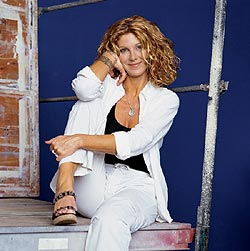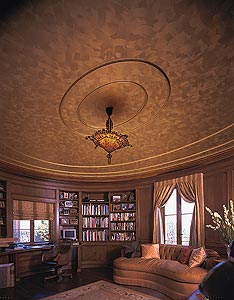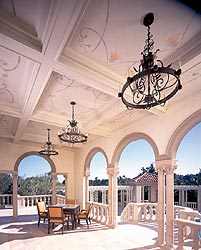
Jo LeSoine - Real Illusions Inc., Venice, California
Jo LeSoine decided she had to go to school to learn how to paint — really paint. Trained by master artisans in Europe and the United States, LeSoine delved into all facets of decorative painting and finishes, including trompe l’oeil and Venetian plaster, during a sabbatical of sorts in upstate New York.
by Stacey Enesey Klemenc
of Real Illusions Inc. how she creates her rich, lively wall surfaces, she tends to be vague. “It’s the twist of the hand, the sweep of the arm,” she’ll say. It’s the competent team she’s assembled and the way the crew is rotated to keep the look consistent. It’s the right combination of products, and it’s the years and years she’s devoted to her profession to arrive where she’s at today.
All told, she’s basically not telling. Like all good illusionists, she’s not about to reveal her tricks … which also happen to be the secret to her success.
But here’s a hint: She’d never dream of using a sponge. Cheesecloth, hands and whatever else are fair game to create a finish. “Our specialty is that no one can tell how we do it,” she says. “What makes my company unique is our ability of hiding the tool. If you can see how it’s done, then forget it. It just won’t pass for me.”
LeSoine was born 46 years ago in England. As a teenager, she studied at the Royal College of Music in London and played French horn. When she was 19, she volunteered to work in a kibbutz in Israel, where a tragic accident changed the course of her life. “I was picking apples in a cherry picker when the whole machine toppled and fell across my legs. I was unconscious for days,” she recalls. “I’m very lucky to be alive.”
As a result of the accident and the ensuing concussion, she incurred blind spots in both eyes, she says — explaining that her field of vision is slightly marred by these “sausage-shaped things” similar to the spots experienced by migraine sufferers. “It makes me more observant because I have to pay attention and look at the whole picture.”
 Indeed, the disability hasn’t slowed her down a bit. “Jo sees with an eye of distinction,” Waldo Fernandez, president of Waldo’s Design, says of LeSoine, who meticulously creates finishes ranging from multilayered Venetian plaster and metallic finishes to faux stones and gilding. Indeed, the disability hasn’t slowed her down a bit. “Jo sees with an eye of distinction,” Waldo Fernandez, president of Waldo’s Design, says of LeSoine, who meticulously creates finishes ranging from multilayered Venetian plaster and metallic finishes to faux stones and gilding.
But it wasn’t always so, LeSoine says. She remembers falling in love with painting after she had come to the United States to become a teacher of the Alexander Technique, an innovative approach to physical education and health that had helped her overcome many problems caused by the accident. She was about 30 at the time and someone gave her a book on faux finishes. It was a terrible book, she recalls, but it consumed her, and she painted all the walls in the house. Her former husband, who had been nearly blind, came home after cataract surgery and “really saw the walls for the first time. He nearly had a heart attack,” she says with a laugh.
That’s when she decided she had to go to school to learn how to paint — really paint. She studied in San Francisco under the tutelage of Gail Lawrence for two years. “Gail nurtured us like we were her own children,” LeSoine says about her 12-person class. Lawrence taught them about fresco and gilding, faux marble and gold leafing, all very old techniques. “My work was not acceptable unless it was perfect. She taught me to see when something wasn’t a keeper to throw it out and start over.”

Trained by master artisans in Europe and the United States, LeSoine delved into all facets of decorative painting and finishes, including trompe l’oeil and Venetian plaster, during a sabbatical of sorts in upstate New York. For five years, she toiled in her studio to perfect the methods learned from the masters so she could translate them into her own applications.
“I fell in love with paint,” she confesses. “I was passionate about it then and I still am. Color still excites me.”
She describes her work then and now as experimentation rather than research. “I took all the ancient things I learned, kept the basic principals and threw everything else out so I could reinterpret the basic finishes,” she says. “I’d say I get 50 percent of my knowledge from sitting over a bucket of paint, dropping tint in it and mixing colors.”
And, just like in the olden days, all of her mixing is done by hand. To help keep things orderly, she has created hundreds of recipes documenting every sample she’s ever done. She keeps glazes in wet form and labels them by date and color. This way, she says, “If I have to touch up something, it’s there.” And if she needs to recreate a mixture, “I know how to do it because everything is written down and catalogued. Every sample is numbered.
This huge array of samples is one of the things that makes her company in Venice, Calif., stand head and shoulders above her competition, she says. “We have hundreds of finished Venetian plaster and faux samples. It’s a huge library. Plus, for our clients, we do a custom sample in a two- to three-day turnaround at no charge.”
And her clients are something to crow about. From AOL/Warner Brothers, MTV, the Discovery Channel and Disney Interactive to the Ahmanson Theater in Los Angeles; the Hollywood Wax Museums in L.A. and Bronson, Mo.; the Getty Museum in L.A.; Larry Flynt Publications in Beverly Hills and the former Elvis mansion in Bel Air, the list reads like a who’s who edition. And that’s not even including the exclusive private residences of John Malkovich, Billy Crystal and Wesley Snipes, among others whose owners’ names LeSoine would rather not disclose.
LeSoine maintains that she brought Venetian plaster to Los Angeles in 1989. “I used to only use original plaster from Italy, but now I use a combination of products both natural and synthetic,” she says. All are water-based acrylics. Most of her Venetian plaster finishes consist of six or seven layers, sometimes more. “We keep layering semi-translucent products to create an illusion of mass and depth. You can be as creative with plaster as paint.”
Real Illusions’ faux finishes are so realistic it’s hard to tell they’re imitations. But the price is the real difference. Instead of paying $60 a foot for marble, for instance, clients could go with the Venetian plaster finish called Scarpa at $12 a foot. And it’s not a problem applying this finish to a big curved wall, something you can’t do with real marble.
For years, LeSoine says, she was the “crew.” But painting on job sites and proving that she is as good as everybody else out there — day in and day out — are part of her past. “I still create the samples, but I don’t need to prove anything anymore. I’m there to direct if it’s a really big job or if I need to figure out how to get things done on site, but the crew does the actual job.”
Recently, she added a marketing director to help streamline the business, cut down on the amount of personal presentations and develop some “fancy marketing tools” that they can take to trade shows and such. “With Darren on board, he’s changing the way people perceive the business,” LeSoine says. “Sure, my fancy brochure may scare some people away, but if they’re interested in quality work, they’ll know we can do it.”
Save for her muralists and trompe l’oeil artists, who need to be highly trained in their specific areas, her crew consists of artisans who came on board almost 10 years ago with no preconceived idea of faux finishes. “I hire someone I like with a good personality who’s lively, attentive, energetic and willing to learn,” she says. “I like to start with a blank slate and train the guys so they can see through my eyes.”
All of her finishes are trademarked, she explains, but she manipulates other people’s products to achieve her results. She has no intention of teaching her methods to other painters besides her crew, but she has some sage advice: “Go to a really good school in decorative art painting and then continue learning on your own.” It has certainly worked for her.

|

